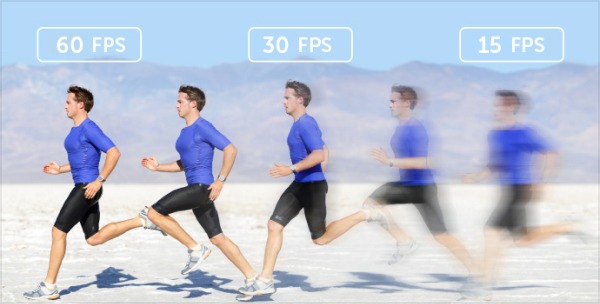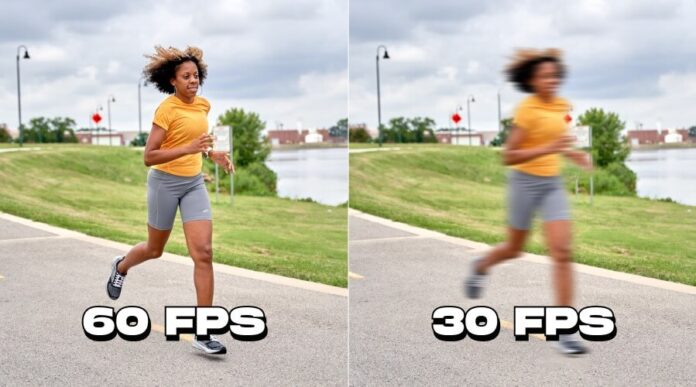In phone videography, the debate between 30 FPS vs. 60 FPS reigns supreme, dictating captured moments’ visual allure and fluidity. Framing the essence of motion, Frames Per Second (FPS) holds the key to unlocking the nuances of video quality.
As smartphone users increasingly turn to their devices as primary recording tools, understanding the disparities between these two frame rates becomes paramount. Delving into this technological tug-of-war unveils a world where every frame counts, shaping the narrative of our visual experiences. Join us as we unravel the intricacies of 30 FPS vs. 60 FPS for phone videos.
Here is the complete Guide on 30 FPS vs 60 FPS Videos
 Understanding FPS
Understanding FPS

Image Source: wowza
I. Definition and Function
Frames Per Second (FPS) is a fundamental metric in video production, representing the frequency at which consecutive images, or frames, are displayed per second. Essentially, FPS determines the smoothness and fluidity of motion within a video. Higher FPS values result in smoother motion, while lower FPS values may exhibit more noticeable stuttering or choppiness. In essence, FPS serves as the heartbeat of video playback, regulating how images transition to create a cohesive visual narrative.
II. Common FPS Rates in Video Recording
Video recording devices typically offer a range of FPS options, each tailored to specific preferences and requirements. Depending on the device’s capabilities, common FPS rates include 24, 30, 60, and even higher values, such as 120 or 240 FPS. 24 FPS is often associated with cinematic aesthetics, providing a traditional and slightly stylized look to videos. 30 FPS is a standard choice for most video recording scenarios, balancing smooth motion and efficient file sizes. Meanwhile, 60 FPS offers enhanced fluidity, particularly suitable for fast-paced action scenes or gaming content.
III. How FPS Affects Video Quality
The choice of FPS profoundly influences a video’s perceived quality and viewing experience. Higher FPS values resulted in smoother motion and reduced motion blur, particularly in fast-moving scenes. This enhanced fluidity can create a more immersive viewing experience, especially on high-refresh-rate displays. Conversely, lower FPS values may introduce visible stuttering or judder, detracting from the overall quality and realism of the video. Moreover, FPS interacts with other factors, such as resolution and bitrate, to determine the overall clarity and fidelity of the video output. Thus, selecting the appropriate FPS is crucial in achieving the desired balance between visual quality, performance, and file size efficiency.
 Advantages of 30 FPS for Phone Videos
Advantages of 30 FPS for Phone Videos
I. Smooth Playback on Most Devices:
30 FPS videos ensure seamless playback across a wide range of devices and platforms, offering a consistent viewing experience for users regardless of their device specifications. This widespread compatibility minimizes the risk of playback issues or stuttering, guaranteeing that videos can be enjoyed smoothly on smartphones, tablets, computers, and other multimedia devices.
II. Lower Battery Consumption
Recording videos at 30 FPS consumes less battery power than higher frame rates, resulting in extended battery life during video capture sessions. This advantage is particularly beneficial for users who frequently engage in video recording activities and prioritize maximizing their device’s battery longevity.
III. Reduced Storage Space Usage
Videos recorded at 30 FPS occupy less storage space, making them an efficient choice for users with limited storage capacity. The smaller file sizes allow users to capture more footage without quickly depleting available storage, ensuring they can continue recording without interruptions or concerns about storage constraints.
Also See: How to Wireless Charge Your Phone
 Advantages of 60 FPS for Phone Videos
Advantages of 60 FPS for Phone Videos

Image Source: smartprix
I. Enhanced Motion Fluidity
Recording videos at 60 FPS offers superior motion fluidity, resulting in smoother and more lifelike transitions between frames. This enhanced fluidity is particularly noticeable during panning shots, fast-moving action sequences, or capturing dynamic subjects, allowing for a more immersive viewing experience.
II. Better for Fast-moving Scenes
60 FPS is better suited for capturing fast-moving scenes with precision and clarity. The higher frame rate ensures that each frame captures more detail, reducing motion blur and preserving the sharpness of the image even in rapid motion. This makes 60 FPS ideal for recording sports events, action sequences, or any scenario with quick movements.
III. Improved Viewing Experience on High-Refresh-Rate Displays
Videos recorded at 60 FPS provide an enhanced viewing experience on high-refresh-rate displays, such as gaming monitors or smartphones with advanced screen technologies. The higher frame rate synchronizes seamlessly with the display’s refresh rate, resulting in smoother playback and a more visually pleasing experience for the viewer.
 30 fps vs 60 fps difference in Real-world Scenarios
30 fps vs 60 fps difference in Real-world Scenarios
I. Comparison of Video Samples: 30 FPS vs. 60 FPS video
Directly comparing video samples captured at 30 FPS and 60 FPS highlights noticeable differences in motion fluidity and detail clarity. In scenarios involving rapid movements, such as a running athlete or a speeding vehicle, videos recorded at 60 FPS exhibit smoother transitions between frames and reduced motion blur compared to their 30 FPS counterparts. Additionally, subtle details and fine textures are more pronounced in 60 FPS videos, enhancing overall visual fidelity and realism.
II. Analysis of Specific Situations (e.g., Sports, Action Shots, Slow-motion)
In sports and action photography, 60 FPS excels at capturing fast-paced moments with precision and clarity, ensuring that every crucial frame is preserved without sacrificing detail. Conversely, 30 FPS may struggle to keep up with the rapid movements, resulting in motion blur and loss of detail, particularly in high-intensity situations. Both frame rates can be utilized effectively for slow-motion footage, but 60 FPS offers smoother slow-motion playback with more frames available for interpolation, resulting in a more natural and fluid effect.
 Factors to Consider When Choosing FPS for Phone Videos
Factors to Consider When Choosing FPS for Phone Videos

Image Source: dacast
I. Purpose of the Video
The intended use of the video plays a crucial role in determining the optimal FPS. For casual videos, such as vlogs or everyday moments, 30 FPS may be adequate, offering a balance between visual quality and efficiency. However, 60 FPS provides smoother motion and enhanced detail for capturing fast-paced action or creating cinematic sequences, elevating the overall viewing experience.
II. Device Compatibility
Consider the capabilities of your device when choosing the FPS for video recording. While most modern smartphones support both 30 FPS and 60 FPS recording, older or budget devices may have limitations. Ensure your device can handle the chosen frame rate without compromising performance or encountering compatibility issues during playback and editing.
III. Storage and Battery Constraints
Higher FPS rates result in larger file sizes and increased battery consumption. If storage space or battery life is limited, opting for 30 FPS may be more practical, as it consumes less storage and battery power than 60 FPS. However, if storage and battery constraints are not a concern, choosing a higher frame rate can enhance the quality and fluidity of your videos.
Conclusion
In the dynamic realm of phone videography, the contrast between 30 FPS vs. 60 FPS delineates a crucial decision-making juncture for creators. Each frame rate offers distinct advantages, catering to diverse preferences and usage scenarios. While 30 FPS ensures broad device compatibility, lower battery consumption, and efficient storage usage, 60 FPS renders enhanced motion fluidity and detail clarity, particularly in fast-paced scenes.
Ultimately, the choice between 30 FPS vs 60 FPS videos hinges on individual needs, balancing practical considerations with the pursuit of optimal visual quality. Embrace the nuances, experiment, and let your creative vision dictate the frame rate that best amplifies your storytelling prowess.

